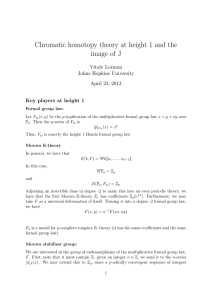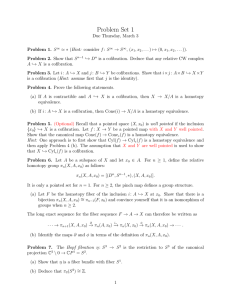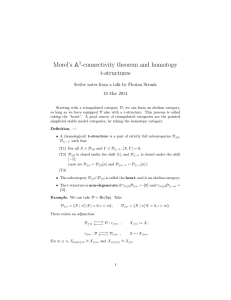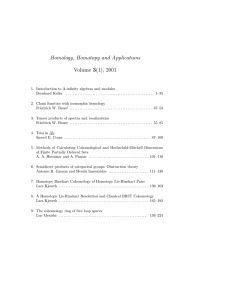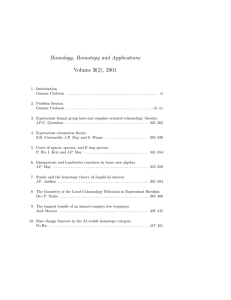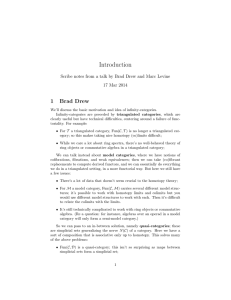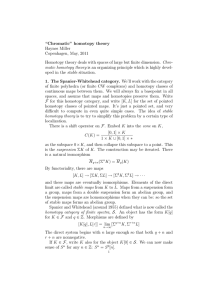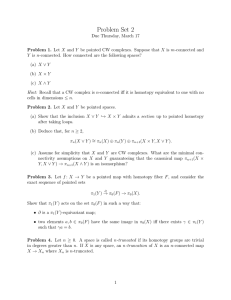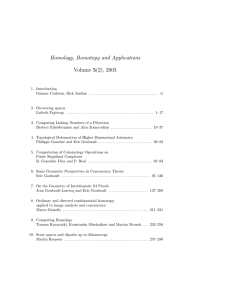The J -homomorphism 1 Chromatic level 1 Vitaly Lorman
advertisement
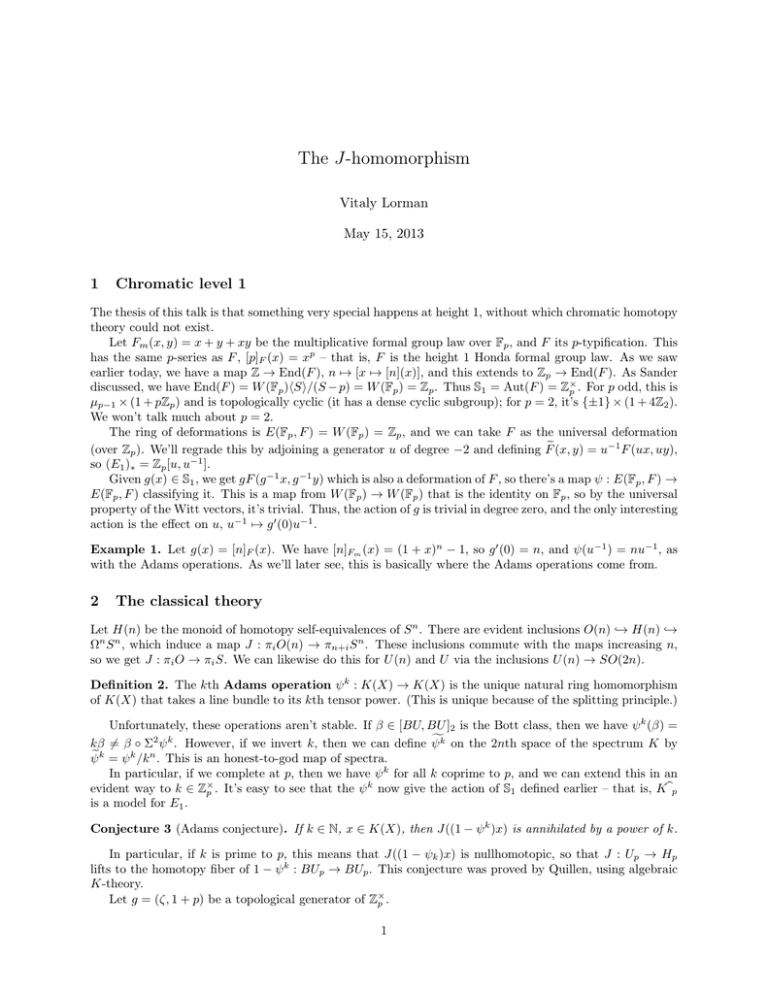
The J-homomorphism
Vitaly Lorman
May 15, 2013
1
Chromatic level 1
The thesis of this talk is that something very special happens at height 1, without which chromatic homotopy
theory could not exist.
Let Fm (x, y) = x + y + xy be the multiplicative formal group law over Fp , and F its p-typification. This
has the same p-series as F , [p]F (x) = xp – that is, F is the height 1 Honda formal group law. As we saw
earlier today, we have a map Z → End(F ), n 7→ [x 7→ [n](x)], and this extends to Zp → End(F ). As Sander
discussed, we have End(F ) = W (Fp )hSi/(S − p) = W (Fp ) = Zp . Thus S1 = Aut(F ) = Z×
p . For p odd, this is
µp−1 × (1 + pZp ) and is topologically cyclic (it has a dense cyclic subgroup); for p = 2, it’s {±1} × (1 + 4Z2 ).
We won’t talk much about p = 2.
The ring of deformations is E(Fp , F ) = W (Fp ) = Zp , and we can take F as the universal deformation
(over Zp ). We’ll regrade this by adjoining a generator u of degree −2 and defining Fe(x, y) = u−1 F (ux, uy),
so (E1 )∗ = Zp [u, u−1 ].
Given g(x) ∈ S1 , we get gF (g −1 x, g −1 y) which is also a deformation of F , so there’s a map ψ : E(Fp , F ) →
E(Fp , F ) classifying it. This is a map from W (Fp ) → W (Fp ) that is the identity on Fp , so by the universal
property of the Witt vectors, it’s trivial. Thus, the action of g is trivial in degree zero, and the only interesting
action is the effect on u, u−1 7→ g 0 (0)u−1 .
Example 1. Let g(x) = [n]F (x). We have [n]Fm (x) = (1 + x)n − 1, so g 0 (0) = n, and ψ(u−1 ) = nu−1 , as
with the Adams operations. As we’ll later see, this is basically where the Adams operations come from.
2
The classical theory
Let H(n) be the monoid of homotopy self-equivalences of S n . There are evident inclusions O(n) ,→ H(n) ,→
Ωn S n , which induce a map J : πi O(n) → πn+i S n . These inclusions commute with the maps increasing n,
so we get J : πi O → πi S. We can likewise do this for U (n) and U via the inclusions U (n) → SO(2n).
Definition 2. The kth Adams operation ψ k : K(X) → K(X) is the unique natural ring homomorphism
of K(X) that takes a line bundle to its kth tensor power. (This is unique because of the splitting principle.)
Unfortunately, these operations aren’t stable. If β ∈ [BU, BU ]2 is the Bott class, then we have ψ k (β) =
fk on the 2nth space of the spectrum K by
kβ 6= β ◦ Σ2 ψ k . However, if we invert k, then we can define ψ
ψek = ψ k /k n . This is an honest-to-god map of spectra.
In particular, if we complete at p, then we have ψ k for all k coprime to p, and we can extend this in an
k
b
evident way to k ∈ Z×
p . It’s easy to see that the ψ now give the action of S1 defined earlier – that is, K p
is a model for E1 .
Conjecture 3 (Adams conjecture). If k ∈ N, x ∈ K(X), then J((1 − ψ k )x) is annihilated by a power of k.
In particular, if k is prime to p, this means that J((1 − ψk )x) is nullhomotopic, so that J : Up → Hp
lifts to the homotopy fiber of 1 − ψ k : BUp → BUp . This conjecture was proved by Quillen, using algebraic
K-theory.
Let g = (ζ, 1 + p) be a topological generator of Z×
p.
1
2
hZ×
p
Proposition 4. The homotopy fiber Jp of (1 − ψ g ) is Kp
= E1hS1 = LK(1) S.
g
hZ
Sketch of proof. g generates a cyclic subgroup Z ⊆ Z×
p , and the homotopy fiber of (1 − ψ ) is Kp . There’s
a map of homotopy fixed point spectral sequences
×
Hc∗ (Z×
p ; Zp )
+3 KphZp
H ∗ (Z; Zp )
+3 KphZ .
One can compute the groups on the left, and show that the left-hand map is an isomorphism.
Adams showed that πn (Jp ) is a split summand of π∗ S(p) for n ≥ 0. So the above proposition identifies
the classical picture and the chromatic one.
Moreover, we can use this to compute π∗ LK(1) S. After all, there’s a fiber sequence
1−ψ g
LK(1) S → Kp → Kp .
πn Kp is zero for odd n, and in even n, ψ g acts by g k . We thus get
n = 0, −1
Zp
πn LK(1) S = Z/pr+1 Z n = 2(p − 1)pr `, p 6| `
0
otherwise.
Definition 5. The Bernoulli numbers are defined via the power series
∞
X xt
x
=
βt .
ex − 1
t!
t=0
We have β1 =
−1
2
and β2t+1 = 0 for t > 0. We let m(2s) be the denominator of
β2s
4s .
Then the above r+1 is vp (m((n+1)/2)), so that the order of the cyclic group πn LK(1) S is the p-component
β
of the denominator of (n+1)/2
n+1 .
At height 1, the chromatic fracture square is given by
LE(1) S
/ LK(1) S
LE(0) S
/ LE(0) LK(1) S.
Of course, LE(0) is just rationalization, i.e. smashing with HQ = SQ. Thus LE(0) LK(1) S has homotopy
groups Qp in degrees 0 and −1 and 0 otherwise. We can thus compute the E(1)-local sphere:
πn LK(1) S n 6= 0, −1, −2
Q /Z
n = −2
p
p
πn LE(1) S =
Z
n=0
0
otherwise.
Adams began (in On the groups J(X) IV) by defining a map π2m−1 (S 2n ) → Q/Z, called the e-invariant.
Let g : S 2m−1 → S 2n be a representative element of this homotopy group, with cofiber Cg . We get a diagram
0
e 2m )
/ K(S
e g)
/ K(C
e 2n
/ K(S
/0
0
e ∗ (S 2m ; Q)
/H
e ∗ (Cg ; Q)
/H
e ∗ (S 2n ; Q)
/H
/0
3. CONSTRUCTING A V1 -SELF MAP
3
where the vertical maps are the Chern character. If α and a are images of generators along the lefthand horizontal maps, and β and b preimages of generators along the right-hand horizontal maps, we have
ch(β) = ra + b for some r ∈ Q, which is well-defined mod Z. This is the e-invariant of g.
e ), K(X)).
e
Also, for any f : X → Y , we define its d-invariant to be d(f ) = f ∗ ∈ Hom(K(Y
If d(f ) =
e
e
e
d(Σf ) = 0, then there’s a short exact sequence 0 → K(ΣX) → K(Cf ) → K(Y ) → 0, and we could also
e ), K(X))
e
define the e-invariant of f as the element of Ext1 (K(Y
representing this.
Adams showed that if f ∈ π2k−1 U (n), then e(Jf ) is the denominator of the Bernoulli number given
above. If g = Jf ∈ π2n+2k−1 S 2n , then CJf ' T (Ef ), the Thom spectrum of Ef and this isomorphism sends
β to the Thom class.
3
Constructing a v1 -self map
Theorem 6. If p is odd, m = pf , and r = (p − 1)pf −1 , then there exists a class α ∈ π2r−1 S such that
(i) mα = 0,
(ii) e(α) = −1/m, and
(iii) the Toda bracket hm, α, mi is 0 mod m.
If we have such a class α, then for q sufficiently large, we have maps
m
α
m
S 2q+2r−2 → S 2q+2r−2 → S 2q−1 → S 2q−1
whose Toda bracket we can form, a map hm, α, mi : S 2q+2r−1 → S 2q−1 . Since this is zero mod m, it factors
m
through the Moore space Y that is the cofiber of S 2q−1 → S 2q−1 , giving a map A : Σ2r Y → Y . We have a
diagram
α
/ S 2q
S 2q+2r−1
O
i
j
Σ2r Y
A
/ Y.
where i is the inclusion of the bottom cell and j is projection to the top cell.Adams discovered rules for the
d- and e-invariants of compositions in terms of the invariants of the individual factors. IN particular,
d(j)d(A) = d(jA) = d(i)e(α) = −me(α) = 1,
proving that A is an isomorphism on K-theory.
We can in fact iterate this. Let A(s) = A ◦ Σ2r A ◦ · · · ◦ Σ2r(s−1) A, a map Σ2rs Y → Y . Including the
bottom cell and projecting to the top cell gives a map αs : S 2q+2rs−1 → S 2q . As before, you can show
that e(αs ) = −1/m, so that αs is in particular nontrivial in homotopy. This was the first infinite family of
elements found in the stable homotopy groups of spheres.
